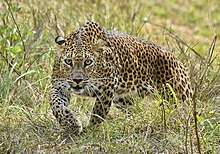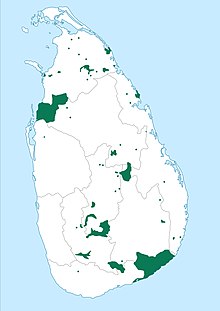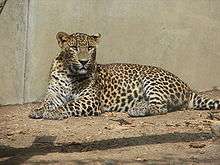Sri Lankan leopard
The Sri Lankan leopard (Panthera pardus kotiya) is a leopard subspecies endemic to Sri Lanka. It was first described in 1956 by the Sri Lankan zoologist Paules Edward Pieris Deraniyagala.[1]
| Sri Lankan leopard | |
|---|---|
 | |
| Sri Lankan leopard in Wilpattu National Park | |
| Scientific classification | |
| Kingdom: | Animalia |
| Phylum: | Chordata |
| Class: | Mammalia |
| Order: | Carnivora |
| Suborder: | Feliformia |
| Family: | Felidae |
| Subfamily: | Pantherinae |
| Genus: | Panthera |
| Species: | |
| Subspecies: | P. p. kotiya |
| Trinomial name | |
| Panthera pardus kotiya Deraniyagala, 1956 | |
 | |
| Distribution of the Sri Lankan leopard | |
Since 2008, the Sri Lankan leopard has been listed as Endangered on the IUCN Red List. The wild population is roughly estimated at 700–950 individuals as of 2015.[2]
Characteristics

The Sri Lankan leopard has a tawny or rusty yellow coat with dark spots and close-set rosettes, which are smaller than in Indian leopards. Seven females measured in the early 20th century averaged a weight of 64 lb (29 kg) and had a mean head-to-body-length of 3 ft 5 in (1.04 m) with a 2 ft 6.5 in (77.5 cm) long tail, the largest being 3 ft 9 in (1.14 m) with a 2 ft 9 in (84 cm) long tail; 11 males averaged 124 lb (56 kg), the largest being 170 lb (77 kg), and measured 4 ft 2 in (1.27 m) with a 2 ft 10 in (86 cm) long tail, the largest being 4 ft 8 in (1.42 m) with a 3 ft 2 in (97 cm) long tail.[3]
The Sri Lankan leopard has allegedly evolved to become a rather large leopard subspecies, because it is an apex predator without competition by other large wild cat species in the country. Large males reach almost 220 lb (100 kg).[4]
Melanistic leopards are rare. Only four records exist, from Mawuldeniya, Pitadeniya and Nallathanniya.[5] In October 2019, the Department of Wildlife Conservation recorded live footage of melanistic individuals for the first time, reportedly documenting four different animals – one female, one male, and two cubs.[6]
Distribution and habitat
.jpg)

The Sri Lankan leopard used to occur in all habitats throughout the island. These habitat types can be broadly categorized into:[7]
- arid zone with <1,000 mm (39 in) rainfall;
- dry zone with 1,000–2,000 mm (39–79 in) rainfall;
- wet zone with >2,000 mm (79 in) rainfall.
In Sri Lanka's central hills, leopards have been recorded in forest patches, tea estates, grasslands, home gardens, pine and eucalyptus plantations.[8]
Ecology and behaviour
A study in Yala National Park indicates that Sri Lankan leopards are not any more social than other leopard subspecies. They are solitary hunters, with the exception of females with young. Both sexes live in overlapping territories with the ranges of males overlapping the smaller ranges of several females, as well as overlapping the ranges of neighbouring males. They prefer hunting at night, but are also active during dawn and dusk, and daytime hours. They rarely haul their kills into trees, which is likely due to the lack of competition and the relative abundance of prey. Since the leopard is the apex predator in Sri Lanka, it does not need to protect its prey.[9] In 2001 to 2002, adult resident leopard density was estimated at 17.9 individuals per 100 km2 (39 sq mi) in Block I of Yala National Park in Sri Lanka's southeastern coastal arid zone. This block encompasses 140 km2 (54 sq mi), contains coastal plains and permanent human-made and natural waterholes, which combined allow for a very high density of prey species.[2]
The Sri Lankan leopard hunts by silently stalking its prey, until it is within striking distance where it unleashes a burst of speed to quickly pursue and pounce on its victim. The prey is usually dispatched with a single bite to the throat. Like most cats, it is pragmatic in its choice of diet which can include small mammals, birds, reptiles as well as larger animals. Axis or spotted deer make up the majority of its diet in the dry zone. The animal also preys on sambar, barking deer, wild boar and monkeys.[10]
There appears to be no birth season or peak, with births scattered across months.[9] A litter usually consists of two to four cubs.
The leopard is sympatric with the Sri Lankan sloth bear.[11][12]
Threats
The survival of the Sri Lankan leopard is threatened due to habitat loss and fragmentation primarily with some levels of direct poaching and direct and indirect human-leopard related leopard deaths.[2] Three individuals were killed by snare traps in the Sinharaja conservation area, one of which is stuffed and displayed at the Giritale Wildlife Museum.[13] In May 2020, another wounded leopard was found and rescued at the Lakshapana Estate in Nallathanniya, Hatton. Later, it was transported to the Randenigala Veterinary Hospital for treatment. Then the animal was transferred to Elephant Transit Home in Udawalawa, where it died while receiving treatments. The snare had heavily injured its neck.[14][15]
Conservation

Further research into the Sri Lankan leopard is needed for any conservation measure to be effective. The Leopard Project under the Wilderness and Wildlife Conservation Trust (WWCT) is working closely with the Government of Sri Lanka to ensure this occurs. The Sri Lanka Wildlife Conservation Society will also undertake some studies. The WWCT is engaged throughout the island with targeted work ongoing in the central hills region where fragmentation of the leopard's habitat is rapidly occurring.[16]
In captivity
As of December 2011, there are 75 captive Sri Lankan leopards in zoos worldwide. Within the European Endangered Species Programme 27 male, 29 female and 8 unsexed individuals are kept.[17]
Cultural significance
Local names
The leopard is colloquially known as kotiya (Sinhala: කොටියා) and chiruthai (Tamil: சிறுத்தை).[3] Panthera pardus kotiya is the kotiyā proper.[18]
In the late 1980s and early 1990s, the word 'kotiya' was being frequently incorrectly translated into English as "tiger" in Sri Lankan media due to incorrect information that was received from the then head of the Wildlife Department in Sri Lanka. He allegedly said that "there are no kotiyas (tigers) in Sri Lanka but diviyās", misinterpreting P. p. kotiya as "diviyā". The word "diviyā" refers to small wild cats such as "Handun Diviyā" or "Kola Diviyā". Both names are used interchangeably for the fishing cat and the rusty-spotted cat. Traditional Sinhala idioms such as 'a change in the jungle will not change the spots of a "kotiyā"', confirms the traditional use of 'kotiyā' to refer to the leopard and not to the tiger.
As a symbol
The Liberation Tigers of Tamil Eelam (Tamil Tigers) were colloquially known to the Sinhala-speaking community as 'Koti', the plural form of 'Kotiyā'. The Tamil Tigers have chosen the Sri Lankan leopard as the national animal of the aspired state of Tamil Eelam,[19] and the Chola Tiger as its flag. A soccer team which is called the Tamil Eelam national football team which plays on ConIFA has the Sri Lankan leopard on their emblem.
See also
Leopard subspecies: African leopard · Arabian leopard · Anatolian leopard · Persian leopard · Indian leopard · Indochinese leopard · Javan leopard · Amur leopard · Panthera pardus spelaea
References
- Deraniyagala, P. E. P. (1956). "The Ceylon leopard, a distinct subspecies". Spolia Zeylanica. 28: 115–116.
- Stein, A.B.; Athreya, V.; Gerngross, P.; Balme, G.; Henschel, P.; Karanth, U.; Miquelle, D.; Rostro, S.; Kamler, J.F. & Laguardia, A. (2016). "Panthera pardus". IUCN Red List of Threatened Species. 2016: e.T15954A160698029.
- Pocock, R.I. (1939). "Panthera pardus (Linnaeus). The Leopard or Panther". The Fauna of British India, including Ceylon and Burma. Mammalia. 1. London: Taylor and Francis. pp. 222–231.
- "Yala's giant leopards". BBC Earth. 2014. Retrieved 2018-01-16.
- "Black Panther rediscovered in SLa". Daily News. Retrieved 2020-05-31.
- "Rare Black Panther Rediscovered In Sri Lanka". iflscience. Retrieved 2020-05-31.
- Phillips, W. W. A. (1984). Manual of the mammals of Sri Lanka. Part III (Second revised ed.). Colombo: Wildlife and Nature Protection Society of Sri Lanka.
- Kittle, A. M.; Watson, A. C.; Chanaka Kumara, P. H.; Nimalka Sanjeewani, H. K. (2014). "Status and distribution of the leopard in the central hills of Sri Lanka". Cat News. 56: 28−31.
- Kittle, A.; Watson, A. (2005). "A short report on research of an arid zone leopard population (Panthera pardus kotiya), Ruhuna (Yala) National Park, Sri Lanka". The Wilderness and Wildlife Conservation Trust, Sri Lanka.
- Kittle, A. M.; Watson, A. C.; Kumara, P. H. C.; Sandanayake, S. D. K.; Sanjeewani, H. K. N.; Fernando, S. (2014). "Notes on the diet, prey and habitat selection of the Sri Lankan leopard in the central highlands of Sri Lanka". Journal of Threatened Taxa. 6 (9): 6214–6221. doi:10.11609/jott.o3731.6214-21.
- Hadley, B. (2008). The Sloth Bear (PDF). IUCN/SSC Bear Specialist Group. Archived from the original (PDF) on 2008-12-21.
- Brown, G. (1993). The Great Bear Almanac. Lyons & Burford. ISBN 1558212108.
- "SL Black Leopard not extinct; spotted again". Daily Mirror. Retrieved 2020-05-31.
- "Rescued black leopard dies; wildlife officials yet to determine cause of death". Economy Next. Retrieved 2020-05-31.
- "Rare Black Leopard recently rescued from a snare dies". News First. Retrieved 2020-05-31.
- Kittle, A. M.; Watson, A. C.; Fernando, S. (2012). "Notes on the status, distribution and abundance of the Sri Lankan leopard in the central hills of Sri Lanka". Cat News (56).
- International Species Information System (2011). "ISIS Species Holdings: Panthera pardus kotiya, December 2011".
- "Panthera pardus kotiya". Integrated Taxonomic Information System.
- "தமிழீழத்தேசிய-சின்னங்கள translated: National symbols of Tamil Eelam". tccnorway.no.
External links
| Wikimedia Commons has media related to Panthera pardus kotiya. |
| Wikispecies has information related to Panthera pardus kotiya |
- Species portrait Panthera pardus in Asia and short portrait P. pardus kotiya; IUCN/SSC Cat Specialist Group
- The Wilderness and Wildlife Conservation Trust, Sri Lanka: The Leopard Project
- ARKive: Images and movies of the Sri Lankan leopard
- Biggest claimed Sri Lankan leopard (250 lb (110 kg)) from the valley of Gal Oya
